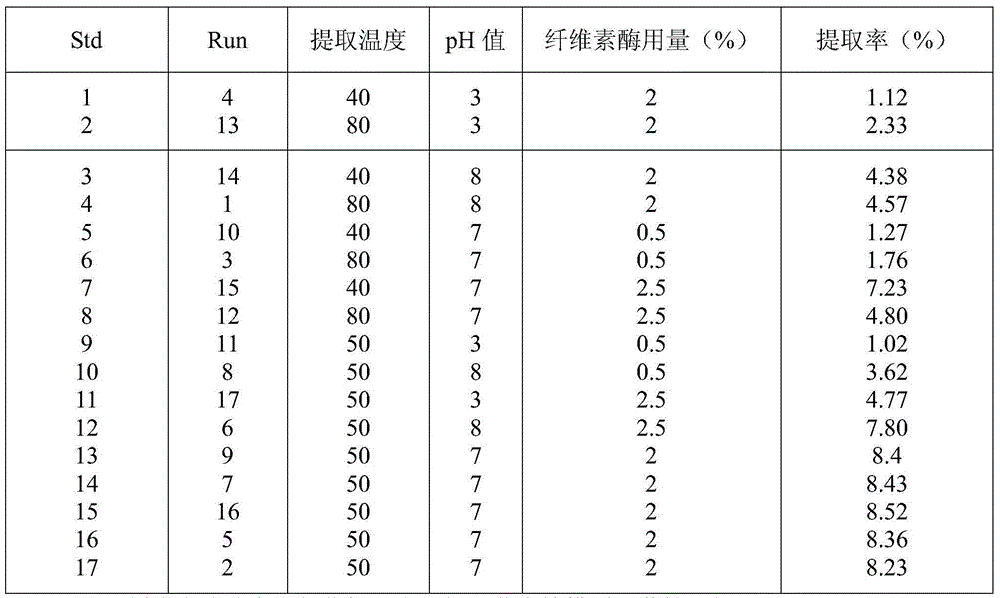Cellulase-catalyzed method for extracting spreading hedyotis herb polysaccharides
A technology for extracting Hedyotis diffusa and enzymatic method is applied in the field of extraction and production technology of active components of traditional Chinese medicine, and can solve the problems of low accuracy, inability to investigate the interaction of factors, and damage to the activity of polysaccharides by extraction temperature, so as to improve the yield and extract Accurate and reliable effect of condition parameters
- Summary
- Abstract
- Description
- Claims
- Application Information
AI Technical Summary
Problems solved by technology
Method used
Image
Examples
Embodiment 1
[0042] Example 1 (1) Extract Hedyotis diffusa by hot water immersion, pulverize, pass through a 40-mesh sieve, weigh Hedyotis diffusa powder, and mix it with water in a ratio of 8 to 12; adjust the pH to about 7 with phosphate buffer , add 1.5-2.5% cellulase to the feed solution, mix well, stir and extract in a water bath at 55°C for 60 minutes;
[0043] (2) Enzyme inactivation: the extracted solution was inactivated at 90° C. for 10 minutes, and the filtrate was obtained by suction filtration;
[0044] (3) Add cellulase hot water to the filter residue for the second leaching: mix the filter residue obtained from the first extraction with water in a ratio of 1:8 to 12 by weight; adjust the pH with phosphate buffer to Around 7, add 1.5-2.5% cellulase, mix well, stir and extract in a water bath at 55°C for 60 minutes;
[0045] (4) Enzyme inactivation: the second filtrate was inactivated at 90° C. for 10 minutes, and the filtrate was obtained by suction filtration; the two filtr...
Embodiment 2
[0058] Example 2 (1) soak Hedyotis diffusa in hot water to extract Hedyotis diffusa and pulverize it, pass through a 40-mesh sieve, weigh 20 grams of Hedyotis diffusa powder, add water to 200 ml, and mix evenly; use phosphate buffer to adjust the pH to about 7, Add 2% cellulase to the feed solution, mix well, stir and extract in a water bath at 55°C for 60 minutes; perform a second extraction on the filter residue, add water to 200 ml, mix well, and adjust the pH to about 7 with phosphate buffer , add 2% cellulase, mix well, stir and extract in a water bath at 55°C for 60 minutes, filter with suction to obtain the filtrate, combine the two filtrates, inactivate the enzyme, and inactivate the enzyme at 90°C for 10 minutes on the filtrate.
[0059] (2) Concentration: Concentrate the filtrate to 30-40 milliliters under vacuum rotation and reduced pressure, and put it to room temperature;
[0060] (3) The first alcohol precipitation: add 95% ethanol to the concentrated solution pr...
PUM
 Login to View More
Login to View More Abstract
Description
Claims
Application Information
 Login to View More
Login to View More - R&D
- Intellectual Property
- Life Sciences
- Materials
- Tech Scout
- Unparalleled Data Quality
- Higher Quality Content
- 60% Fewer Hallucinations
Browse by: Latest US Patents, China's latest patents, Technical Efficacy Thesaurus, Application Domain, Technology Topic, Popular Technical Reports.
© 2025 PatSnap. All rights reserved.Legal|Privacy policy|Modern Slavery Act Transparency Statement|Sitemap|About US| Contact US: help@patsnap.com

